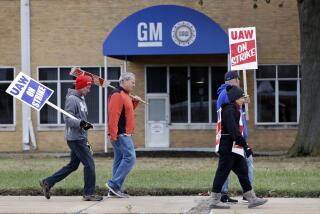An ultimatum for Detroit
- Share via
WASHINGTON — Declaring that the country had reached the end of the road with Detroit’s automakers, President Obama on Monday mapped a new course for bailed-out General Motors Corp. and Chrysler in a series of moves designed to force the hands of workers, creditors and others with a stake in the companies.
Obama, using the threat of bankruptcy as a weapon, vowed to transform the U.S. auto industry by pushing GM and Chrysler to make major changes in exchange for billions in additional taxpayer money they need to survive.
The tactic, including the administration’s ousting over the weekend of GM Chairman and Chief Executive Rick Wagoner, puts the government in the extraordinary position of dictating the ongoing policies of major, largely unregulated firms.
Administration officials said a quick, government-led bankruptcy would be a last resort. But if it comes to that, they said, the court process could be used to separate the companies’ good assets from the bad. The good assets would form stand-alone companies to survive or be sold; the bad assets would be purged.
Obama also said he would seek ways to encourage consumers to buy new cars, sounding like a TV pitchman by promising that the government would guarantee the warranties of GM and Chrysler vehicles even as the companies teeter on the edge of bankruptcy.
“Your warranty will be safe,” Obama said in televised remarks. “In fact, it will be safer than it’s ever been, because starting today, the United States government will stand behind your warranty.”
He also said he was exploring ways to provide tax credits or vouchers for people who trade in older gas guzzlers for new cars, a “cash for clunkers” program that has been used in California and abroad.
And the Internal Revenue Service on Monday began touting a tax break introduced last month that allows some car buyers to deduct from their income taxes the sales and excise taxes on purchases made by the end of the year.
All the moves were designed to save the industry by forcing major changes on two of Detroit’s Big Three. Ford Motor Co. has not sought federal aid.
“Year after year, decade after decade, we’ve seen problems papered over and tough choices kicked down the road, even as foreign competitors outpaced us,” Obama said. “Well, we’ve reached the end of that road.”
News of the government’s actions helped send the stock market tumbling Monday. The Dow Jones industrial average fell 254 points, or 3.2%.
In Michigan, some workers have long seen cataclysmic changes coming.
“Things started going to gunnybags in the early 1980s. It has been a long rough road since then,” said Dave Tattman, who runs GM’s sprawling Powertrain plant in Ypsilanti, Mich., west of Detroit.
“General Motors and the United Auto Workers built the middle class in this country,” Tattman said. “At the end of the day, I have every confidence that GM will continue.”
In Southern California, auto dealers and customers acknowledged that the government had to follow through with its rescue.
“Clearly, we need to go to the next chapter. Dealers realize that the model of the past doesn’t work,” said Leo Bunnin, who owns four GM dealerships in Ventura County.
John Dains, a Santa Monica computer programmer looking at a new Dodge Challenger at Alhambra Chrysler Jeep Dodge, doesn’t believe the government should be involved in private companies.
“But since we’re so far in, they may as well follow through and back up the companies,” he said. “You can’t stop halfway. . . . The horse has already left the barn.”
U.S. officials threatened a government-backed bankruptcy for GM if workers and major holders of nearly $28 billion in the company’s bonds didn’t make more concessions over the next two months. Workers have given up some pay, but bondholders have been more recalcitrant.
And now an ad hoc committee of debt holders wants a say in reorganizing GM.
“We have been very disappointed that the government and the company have had virtually no real dialogue with bondholders while designing the proposed restructuring plan,” the bondholders said in a statement.
Privately held Chrysler, though, faces a different fate.
The administration is forcing Chrysler into the arms of Italian automaker Fiat after the president’s auto task force determined that Chrysler was not viable as a stand-alone company. Chrysler and Fiat already have what they call a framework for an agreement, but there has been little movement reported in several months.
“We cannot, and must not, and we will not let our auto industry simply vanish,” Obama said.
But, he added, its survival can’t depend “on an unending flow of taxpayer dollars.”
“These companies -- and this industry -- must ultimately stand on their own, not as wards of the state,” he said.
The administration took the first step by ousting Wagoner, a move some in Congress had long argued for.
Wagoner won’t get a severance package, but he is eligible for $23 million in pension and other benefits for his 32 years at the company.
But Wagoner’s dismissal didn’t sit well with some Michigan Democrats. Gov. Jennifer Granholm called Wagoner a “sacrificial lamb,” and Sen. Carl Levin said Obama told him Sunday night that “this kind of change was necessary to signal to the public there was going to be a real effort here to make a fresh start.”
“The decision to ask Rick Wagoner to resign is a very sad moment for those of us who are deeply involved in supporting this industry,” Levin said.
But he added that Obama’s other announcements made it “a very positive day for the American automobile industry.”
All of Obama’s announcements were intertwined, reflecting the complicated political and business implications.
Wagoner was pushed out to demonstrate to the public that the White House was serious about forcing change on the automakers. The administration raised the prospect of bankruptcy to force bondholders and the UAW to make new concessions.
And, while talking openly about bankruptcy, Obama also had to assure potential car buyers that their warranties would be honored if the companies disappeared.
“Any further federal money going to the automobile industry without a conspicuous symbol of atonement would have been politically indefensible,” said Ross Baker, a political scientist at Rutgers University. “The symbol was Rick Wagoner’s job.”
In a message to GM employees Monday, Wagoner said he agreed to the administration’s request Friday to step aside and called his replacement as CEO, longtime GM executive Fritz Henderson, “an excellent choice.”
“GM is a great company with a storied history. Ignore the doubters, because I know it is also a company with a great future,” Wagoner told them.
Obama said the decision was “not meant as a condemnation” of Wagoner, but was done because the company needs a “new vision and new direction.”
Some Republicans, however, were alarmed at the decision to oust the head of a private company, even one that has received government bailout money. GM and its financing arm have received a total of about $19.3 billion. Chrysler and its financing arm have received about $5.5 billion.
“This is a remarkable move by the federal government -- I think unprecedented in the history of this country,” said Sen. John McCain (R-Ariz.). “What does this signal send to other corporations and financial institutions about whether the federal government will fire them as well?”
Sen. Bob Corker (R-Tenn.) said the Wagoner firing was designed to shift attention from the lack of progress Obama’s auto task force has made in forcing the restructuring of GM and Chrysler.
“The White House woke up and realized it was going to be an embarrassing moment because nothing really had occurred,” he said. “I think that’s what set off the Wagoner firing, to save face there.”
But with a deadline today to determine the viability of both companies or call for repayment of the loans, the administration navigated a middle path.
It gave Chrysler 30 days to work out a deal with Fiat or another partner. Obama said GM’s restructuring plan wasn’t “strong enough” but that GM could become viable. The White House offered the company 60 days and “adequate working capital” to produce a better restructuring plan. Officials would not say how much money that would be.
“Let me be clear -- the United States government has no interest in running GM,” Obama said. “What we are interested in is giving GM an opportunity to finally make those much-needed changes that will let them emerge from this crisis a stronger and more competitive company.”
--
Contributing to this report were Times staff writers Janet Hook in Washington and Tom Petruno, Ralph Vartabedian and Andrea Chang in Los Angeles.







